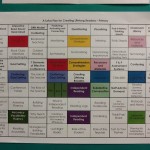We embarked on a whole school approach to increase the reading achievement of students at Hackham East in Term 1, 2013.
Data from internal testing (e.g. PM Reading level benchmarks, TORCH-Reading Comprehension) as well as NAPLAN and teacher observations showed that students required explicit teaching in:
. specific comprehension skills (ie inferring, visualizing, summarizing);
. selecting appropriate reading material;
. developing reading stamina
Sally Slattery (Deputy Principal) led the team of Bob Thiele (Principal), Jonathon Kaesler (Librarian) and myself (Reading Support Teacher) to talk about our vision for developing lifelong readers at our site through programmed weekly meetings in Term 1. Questions such as the ones below were deeply considered, discussed and debated:
. What did we as a school community need to do to improve reading?
. How could we as literacy leaders empower teachers by building their knowledge about their students and about reading instruction?
. How could we shift the focus from measuring reading achievement from test results and attainment of reading levels to other means that would show students the reading behaviours they exhibit and guide them in how to develop certain skills they needed in order to become a proficient reader?
We looked at the big picture through the lens of a “Lotus Diagram” that Sally had been a part of developing across schools in the western suburbs of Melbourne. We met with the Literacy committee (consisting of 5 teachers across Reception- Year 7) to share the Lotus Diagram and to discuss and refine our vision before we took it to the whole staff.



